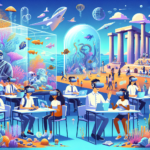XR in Education : The Power of XR in Education 🎓
Understanding Immersive Learning Environments
The landscape of education is evolving, and at the forefront of this revolution are immersive learning environments powered by Extended Reality (XR). XR encompasses Virtual Reality (VR), Augmented Reality (AR), and Mixed Reality (MR), blending the physical and digital worlds to create engaging, interactive learning experiences. This transformation not only enhances the way students absorb information but also significantly boosts their engagement and retention rates. But how exactly does XR do this? Let’s take a deep dive!
The Science Behind Engagement and Retention
XR in Education : When it comes to educational methods, student engagement is crucial. Engaged students are more likely to participate, learn deeply, and retain information longer. Here are a few reasons why XR excels in this domain:
- Active Participation: XR promotes active learning by requiring students to participate directly in the experience. This hands-on approach leads to deeper understanding and memory retention.
- Real-World Applications: XR allows learners to simulate real-world scenarios, making lessons relatable and practical. Students can explore environments that are often impossible to access in a traditional classroom.
- Enhanced Collaboration: Immersive environments foster collaboration among students, encouraging teamwork and interaction that are vital to the learning process.
XR in Education: How XR Stimulates Student Engagement
Immersive Learning Environments powered by XR provide a unique sensory experience that traditional educational tools can hardly replicate. Here’s how XR stimulates student engagement:
1. Interactive Learning Experiences
XR in Education: With XR, students can engage with content in a way that feels alive and dynamic. Instead of passively listening to lectures or reading textbooks, they can:
- Navigate historical landmarks in VR.
- Conduct science experiments safely in a virtual lab.
- Visualize complex mathematical concepts through 3D models.
2. Personalized Learning Paths
XR technology can adapt to individual learning styles and paces, offering:
- Tailored content based on students’ strengths and weaknesses.
- Immediate feedback to help learners adjust their approaches.
3. Gamification and Motivation
Many XR platforms incorporate elements of gamification to keep students motivated. By adding rewards, challenges, and progress tracking, learning feels less like a chore and more like an adventure. This approach significantly increases student motivation and fosters a growth mindset!
XR in Education: The Role of XR in Student Retention
Retention is the measure of how much students remember after they’ve learned something. Here are some specific ways XR enhances retention rates:
1. Multi-Sensory Learning
By tapping into various senses—sight, hearing, and touch—XR fosters a multi-sensory learning environment that promotes longer-lasting memories. The more connected students feel to the material, the more likely they are to remember it.
2. Emotional Engagement
XR has the unique ability to evoke emotions through immersive storytelling and realistic scenarios. Emotional connections significantly boost memory retention, as learners are more likely to remember experiences that resonate with them on a personal level.
3. Repetition and Reinforcement
XR allows learners to revisit content and practice skills repeatedly in a dynamic setting. Whether it’s practicing a foreign language in a virtual café setting or repeating a surgical procedure in a lifelike environment, this repetition in an immersive context strengthens neural pathways associated with the learned material.
Successful Real-World Applications of XR in Education
Several institutions and organizations have successfully adopted XR for educational purposes. Below are a few compelling examples:
1. Virtual Field Trips
Imagine taking students on a virtual field trip to the Pyramids of Giza or the Great Barrier Reef—all from their classroom! Various educational platforms offer immersive field trips that allow students to explore and learn about different cultures and environments without leaving their seats.
2. Medical Training Simulations
Medical schools are increasingly utilizing XR to train future healthcare professionals. With simulated surgeries and emergency situations, students can practice their skills in a safe environment, reinforcing knowledge while boosting confidence.
3. Language Learning with AR
Language programs are increasingly employing AR to create immersive environments where students can practice language skills in real-life contextual settings, enhancing both understanding and retention.
The Future of XR in Education
As technology continues to evolve and XR tools become more accessible, we can expect to see an even greater impact on the educational landscape. The integration of XR in classrooms isn’t just a trend; it’s a fundamental shift that reshapes how students learn and interact with content.
- Enhanced devices and platforms will make XR learning more accessible for schools worldwide.
- Continued research will refine the methodologies, ensuring higher engagement and retention rates.
With various projects and initiatives aimed at integrating XR in education, the future looks promising for both educators and students alike.
Embracing the XR Revolution in Education 🌍
In a world where information is abundant, keeping students engaged and improving their retention of knowledge is paramount. XR technologies offer unparalleled opportunities to create immersive learning environments that not only captivate students but also prepare them for the complexities of the real world. As we continue to explore the vast potential of XR in education, it’s essential for educators, institutions, and technology developers to collaborate toward a future where immersive learning becomes the norm, not the exception.




0 Comments